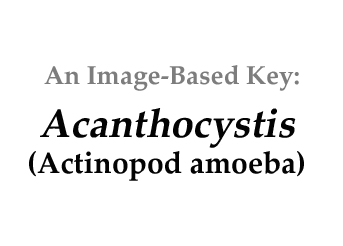|
Home / Amoebae / Non-Testate / Acanthocystis |
||||
|
|
||||
|
Click on images for larger format |
||||
Name derivation: |
||||
|
|
||||
Classification: |
||||
Acanthocystis has been classified in three different kingdoms, either as a fungus under the Basidiomycota, family Pleurotaceae; as a protist in the Centroheliozoa (Patterson 1999), family Acanthocystidae; or in Kingdom Chromista or its synonum Stramenopila (online), family Acanthocystidae. The genus has been placed in four different phyla and five different families (online). |
||||
Morphology: |
||||
|
Actinopods (heliozoans) are heterotrophic spherical unicellular amoebae ~30 - 40 µm diameter with a periplast containing many silicacious bi- or trifurcate spines. Many Acanthocystis individuals contain an abundance of photosynthetic Zoochlorella unicells . Currently ~31 species of Acanthocystis are recognized. However, an online list of 37 spelling variants seems to include at least 12 synonyms based on gender and spelling preference (such as A. aurata and A. auratus; A. petalodes and A. petaloides; and many more). The practical list is probably 25 legitimate species names. The molecular revolution may result in further resolution and revision. |
||||
Similar genera: |
||||
|
Other members of Family Acanthocystidae according to Patterson (1999) include Pseudoraphidiocystis, Pseudoraphidiophrys, Pterocystis, Echinocystis, and Choanocystis |
||||
Habitat: |
||||
|
Freshwater, brackish and marine in distribution. |
||||
References: |
||||
|
Patterson, D.J. 1999. The Diversity of Eukaryotes. The American Naturalist 65:S96-S124. |
||||






